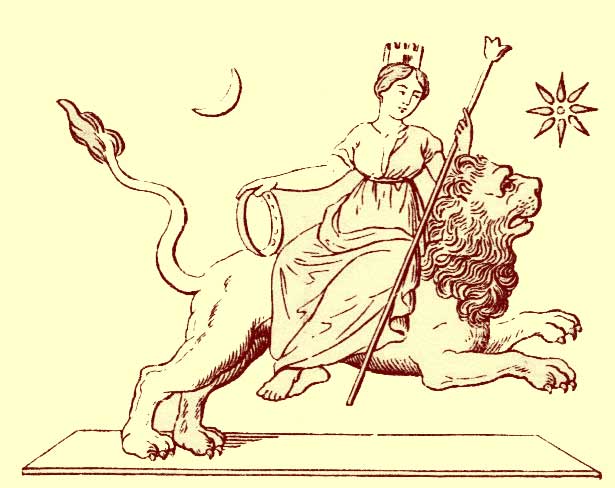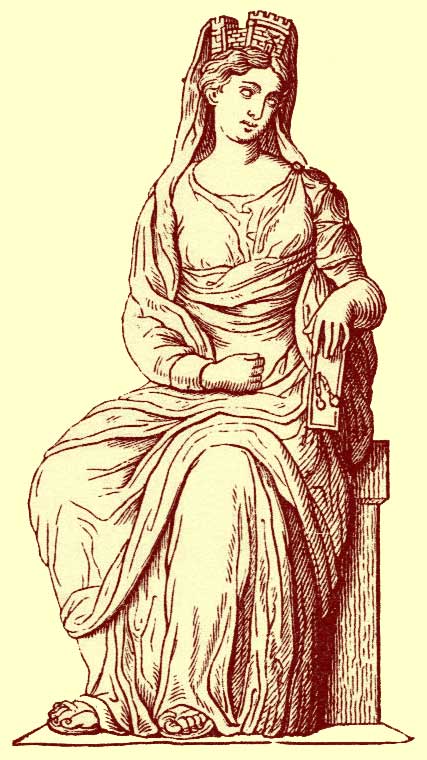
From Manual of Mythology, by Alexander S. Murray; Revised Edition, Philadelphia: David McKay, Publisher, 1895; pp. 49-52.
[49]
Fig. 4. — Rhea.
As Uranus, the representative of the fertilizing force in nature, was superseded by Cronus the representative of a 50 ripening force, so Gæa, the primitive goddess of the earth with its productive plains, gave way to Rhea, a goddess of the earth with its mountains and forest. Gæa had been the mother of the powerful Titans. Rhea was the mother of gods less given to feats of strength, but more highly gifted: viz. Pluto [Hades], Poseidon (Neptune), and Zeus (Jupiter), Hera (Juno), Demeter (Ceres), and Hestia (Vesta). Her titles — as, for example, Dindumenē and Berekuntia — were derived for the most part from the names of mountains in Asia Minor, particularly those of Phrygia and Lydia, since her worship was intimately associated with the early civilization of these countries. There her name was Cybelē or Cybēbē, which also, from its being employed to designate her sanctuaries (Cybela) in caves or mountain sides, points to her character as a mountain goddess.
The lofty hills of Asia Minor, while sheltering on their cavernous sides wild animals, such as the panther and lion, which it was her delight to tame, also looked down on many flourishing cities which it was her duty to protect. In this latter capacity she wore a mural crown, and was styled Mater turrita. But though herself identified with peaceful civilization, her worship was always distinguished by wild and fantastic excitement, her priests and devotees rushing through the woods at night with torches burning, maiming and wounding each other, and producing all the din that was possible from the clashing of cymbals, the shrill notes of pipes, and the frantic voice of song. To account for this peculiarity of 51 her worship, which must have been intended to commemorate some great sorrow, the story was told of how she had loved the young Phrygian shepherd, Attis, whose extraordinary beauty had also won the heart of the daughter of the king of Pessinus; how he was destined to marry the princess, and how the goddess, suddenly appearing, spread terror and consternation among the marriage guests. Attis escaped to the mountains, maimed himself, and died beside a pine tree, into which his soul transmigrated, while from his blood sprang violets like a wreath round the tree. The goddess implored Zeus to restore her lover. This could not be. But so much was granted that his body should never decay, that his hair should always grow, and that his little finger should always move. The pine was a symbol of winter and sadness; the violet, of spring and its hopeful beauty.

Fig. 5. — Rhea.
The first priests of Rhea Cybele were the Curetes and Corybantes, for whom it was also claimed that they had been the first beings of mere human form and capacity that had appeared on the earth, having sprung from the mountain side like trees. The great centre of her worship was always at Pessinus in Phrygia, under the shadow of Mount Dindymon, on which was a cave containing what was believed to be the oldest of her sanctuaries. Within this sanctuary was the tomb of Attis, and an ancient image of the goddess in the shape of a stone, which was said to have fallen from heaven. The first temple at Pessinus had been erected, it was said, by 52 King Midas. Successive rulers of Phrygia maintained and endowed it so liberally that it continued to be a place of importance long after Phrygian civilization had sunk. Spreading from this centre, the worship of Cybele was established first in the neighboring towns of Sardis, Magnesia, Smyrna, Ephesus, Lampascus, and Cyzicus; thence it spread to Athens, and in later times to the mountainous district of Arcadia, where it was locally believed that Zeus had been born and that the creation of mankind had taken place.